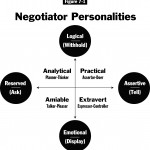Negotiation Tools, Techniques, and Tactics (T3) Part II

Robert Menard, Certified Purchasing Professional, Certified Professional Purchasing Consultant
The inability to communicate effectively will derail the best thought out and researched negotiation plan. To communicate well in English, let alone foreign cultures, we must appreciate the social and physiological factors affecting voice communication, by far the most predominant form.
Communication Elements
The four Literal Elements of communication and their approximate proportions in negotiation are:
- Speaking 30%
- Listening 45%
- Reading 16%
- Writing 09%
The two Figurative Elements that have far more intangible impact are:
- Body Language
- Open Mind

It is also essential to understand the since negotiation is almost universally a stressful event, stress induces a flight or fight behavior. This forces us to our dominant and strongest personality type.
The importance of knowing personality types is that personality types drive one’s communication style. The graphic at the right offers a recap of personality types and the associated communication styles.
Communication Techniques
Here is a recap of some of the techniques that we discussed in the seminars. You’ll find much more detail in Chapter 6 of the book and supplemental information on the 3 CD set.
- Language Clues
- Quickness
- Gaps
- Repetition
- Breathing
- Eraser words
- Announcer statements
- “As you know”
- “By the way”
- Establish expectations
- Anger and confrontation
- Never accept a ‘no’ from someone who cannot say ‘yes.’
- Dumbness
- Never agree or disagree with explanations
- “Tell me about it.”
- What-if” questions
- No
- Non negotiables
- Listening to an ‘extremist’
Tactics
Tactics are purposefully left for last as they are a function of and dictated by your strategy. Nevertheless, tactics come in for quite a bit of glory by those with a superficial mastery of negotiation. The greatest value of tactics is in the old battle filed algae, “A tactic recognized is a tactic neutralized”.
As we grow in negotiation skill, it might be surprising at how obvious or awkward the use of tactics of others will seem. Often, our counterparts will not know or understand the tactics they are using.
Here is a recap of some of the tactics discussed in Chapter 9 of my book. Supplemental information on Personalities and Communication and Tactics is available on the CD sets. For your copy of the book, You’re the Buyer – You Negotiate It, or CD sets, please visit this site.
- Higher Authority
- Split the Difference
- Trading Concessions
- No Statement
The Flyers
- The Flinch
- The Hot Potato
- The Do Better
- Silence
The Gambits
- Good Guy / Bad Guy
- The Invalid Offer
- The Lesser of Two Evils
- Sacred Writings
The Ruses
- The Head Fake
- The Straws
- Funnie Munnie
- Madman Mania
- The Walk
- Artful Anger
- Self Control
- Puppy Dog Close

